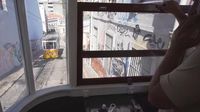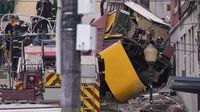Lisbon’s historic heart was rocked on Wednesday, September 3, 2025, when the iconic Gloria Funicular tram derailed on the steep Calçada da Glória, resulting in one of the city’s deadliest public transport disasters in recent memory. The crash left 17 people dead and at least 21 injured, including tourists and locals from at least ten countries, and plunged Portugal into a period of national mourning.
The accident unfolded just after 6 p.m. local time, as the funicular—an emblematic yellow-and-white streetcar with a storied past dating back to 1885—was making its routine climb up the 900-foot hillside, connecting Lisbon’s bustling downtown to the lively Bairro Alto neighborhood. Suddenly, according to eyewitnesses and emergency officials, the tram began to hurtle down the hill at full speed, seemingly without brakes, before careening off the tracks and smashing into a building with devastating force.
“It hit a building with brutal force and collapsed like a cardboard box; it had no brakes,” one woman told Portuguese TV channel SIC, her words echoing the shock and horror felt by many at the scene. Another eyewitness, Teresa d’Avó, described the chaos: “We saw the elevator upstairs was out of control, without brakes, and we all started running away because we thought it was going to hit the one below. But it fell around the bend and crashed into the building.”
Within minutes, clouds of dust filled the narrow street as first responders, including firefighters and medical teams, rushed to the scene. According to Tiago Augusto of the Inem emergency services, all victims were pulled from the wreckage and taken to hospitals within two hours. Among the injured was a three-year-old German child, whose father was tragically among the dead. The boy’s mother remains in serious condition in intensive care, local media reported. A South Korean tourist and two Spanish nationals were also among the injured, highlighting the funicular’s popularity with international visitors.
Authorities confirmed that the victims hailed from at least ten countries, including Portugal, Germany, Spain, South Korea, Cape Verde, Canada, Italy, France, Switzerland, and Morocco. The first identified fatal victim was André Jorge Gonçalves Marques, a 40-year-old brakeman for Carris, the municipal public transport company. His colleagues and union, SITRA, shared heartfelt tributes, remembering him as “always happy and had a smile on your face, always had a kind word, and always willing to help others.”
The immediate aftermath was marked by confusion and fear. Witnesses recalled hearing children screaming for help, and at one point, a bystander shouted, “There are kids under the tram!” A baby pram was seen among the wreckage, a haunting reminder of the families caught up in the tragedy. The Civil Protection Agency later confirmed that only adults were among the dead, with seven men and eight women identified, while two more victims succumbed to their injuries overnight.
As the scale of the disaster became clear, Lisbon’s Mayor Carlos Moedas addressed the city, his voice heavy with emotion: “Lisbon is in mourning. This was a tragic accident … It’s a tragedy of the like we’ve never seen.” Prime Minister Luis Montenegro echoed these sentiments, declaring Thursday, September 4, a national day of mourning and stating, “Today is a day of pain, no words are sufficient to heal your loss and to fill the void that has been left behind by those who have departed. The whole country is sharing in your grief.”
European Union chief Ursula von der Leyen and Spain’s Prime Minister Pedro Sanchez joined in offering condolences, with von der Leyen posting on X, “It is with sadness that I learned of the derailment … My condolences to the families of the victims.” Sanchez added, “Appalled by the terrible accident of the Glória funicular in Lisbon. All our affection and solidarity with the families of the victims and with the Portuguese people in this difficult moment.”
The Gloria Funicular, or Elevador da Glória, is much more than a mode of transportation—it is a symbol of Lisbon, featured in countless tourist photographs and carrying about 3.5 million passengers per year. The tram was electrified in 1915 and, according to Carris, undergoes general maintenance every four years, with the last major work completed in 2022. Pedro Bogas, head of Carris, stated, “Everything was scrupulously respected,” referring to maintenance protocols, and expressed deep sorrow: “We are very sorry about what happened. Today is a day of consternation. We have strict protocols, excellent professionals for many years, and we need to get to the bottom of what happened.”
Despite these assurances, questions have quickly surfaced about the cause of the crash. Early reports suggest that a cable came loose along the route, causing the tram to lose control. The Lisbon Firefighters Regiment attributed the accident to this cable failure, while the Fectrans union’s leader, Manuel Leal, noted that workers had previously complained about the funicular’s brakes—though he cautioned it was too early to say if this played a role. “People say that it was negligence but it was not negligence. They supervise it thoroughly. It was an accident, just like a plane or car accident can happen,” witness Eliane Chaves told Sky News, trying to dispel rumors of systemic failure.
The Portuguese public prosecutor’s office, national transport safety authority, and Carris have all launched investigations into the tragedy. The attorney general’s office confirmed, “As is customary in these types of situations, and as required by law, the public prosecutor’s office will open an investigation.” The company has also promised its own internal review, as concerns from some unions about maintenance standards linger in the background.
Lisbon’s funiculars are vital lifelines in a city defined by its hills, and the Gloria line in particular is woven into the daily rhythms of both residents and tourists. The crash has cast a pall over the capital, raising hard questions about the balance between heritage, safety, and the demands of a modern city. As the investigation continues, the city—and the nation—are left to mourn, remember the victims, and grapple with the aftermath of a tragedy that has shaken Lisbon to its core.
For now, the streets of Lisbon are quieter, the usually cheerful clang of the tram replaced by somber reflection and a resolve to ensure such a disaster never happens again.





